Post Surgical Evaluation and Treatment of the Cervical and Lumbar Spine
Learn something now! - Watch the Online CEU Course Trailer

All Access Online CEU for PT, PTA and OT for $189
BEST VALUE - Includes this course and all our online courses
Subscribe Todaytheaters Purchase Now, Instant Online Course Access
Post Surgical Evaluation and Treatment of the Cervical and Lumbar Spine
$175.00
- CE Hours: 12.0 hrs, 1.2 CEU
- Delivered: Online
- Instant Online Access to Course Material for 365 days, Videos, Online Test and Printable Course Certificate
- No auto-renewal for this option
All Access Online CEU for PT, PTA and OT
$189
All Access Online CEU for PT, PTA and OT Subscription
1 Year Access with Annual Renewal
State specific course completion certificates.
Chat support
Prices are in US dollars- 12 months of access to all online ceu courses, course tests and state approval certificates.
- Meet all your CE requirements. Pre-approved for PT, PTAs in AK, AL, AZ, CA, CO, CT, DC, DE, GA, HI, IA, ID, IL, IN, KS, MA, ME, MI, MO, MS, MT, NC, ND, NE, NH, NM, NV, NY, OR, PA, RI, SC, SD, TN, TX, UT, VA, VT, WA, WI, and WY.
- AOTA approved.
- Designed for Physical Therapists, Occupational Therapists, Athletic Trainers and Assistants.
- Access to future courses and content.
- Start, stop and resume, right where you left off in a course.
- Real patient interviews.
- Medical expert contributors.
- 3D anatomy and medical illustrations.
- Easy to use learning system for fast access to your courses.
- Award winning content.
- Top instructors teaching evidence based skills and techniques.
Why should a physical therapist, occupational therapist, or athletic trainer take this post surgical cervical and lumbar spine continuing education course?
Back pain is one of the most common complaints to a physician. Surgical options are often the treatment of choice to decrease pain and increase function. Many people do not understand the protocols and progression of care that can impact a surgical procedure’s success. Physical therapy pre and post -surgical rehab programs combine education, conditioning, strengthening, and functional activities to enhance the healing environment. A comprehensive approach leads to successful surgical outcomes and functional ability.
This cervical and lumbar spine post surgical CE course is designed to enhance a therapist’s primary and intrinsic understanding of surgical approaches and techniques, including microdiscectomy, PLIF, DLIF, TLIF, ACDF, and posterior cervical fusion in order to optimize the post surgical outcome. Pre and post op evaluation techniques are instructed and dictate the progression of care throughout the healing process.
Rehab clinical tools instructed in oncology course to enhance your functional outcomes.
- Outcomes measure tools to monitor progression throughout the rehab process
- Manual therapy techniques, including adverse neural tensioning and mobilization of the sciatic, femoral, median, ulnar, and radial nerves are demonstrated
- Protocols and instructions for pre-operative, surgery, initial post-operative recovery, and post-operative rehabilitation
Specific instruction that will enhance your understanding and ability to deliver better patient care.
- Rehabilitate a postoperative spinal surgical patient by developing a working understanding of the specific surgical approach, technique, physiological healing time, mechanical post-op changes, and variables involved with each post surgical cervical and lumbar spine patient
- Post operative spinal evaluations, standardized outcomes tools, and how to perform post operative spine evaluations for the various stages of postoperative progression
Features unique to this post surgical cervical and lumbar spine rehabilitation CE Course.
- Post-operative movement precautions, post-surgical neuromuscular effects on specific structures related to the surgery, and healing phases to treat the post-surgical spine patient
- Evidence- based tests used to monitor and optimize post surgical outcome progression
Professional Accreditation
This is an intermediate level course applicable for PT, PTA, OT, AT. Physical Therapy Accreditation: For specific state information use the accreditation verification menu and select your state of license. AOTA: provider #4487, Occupational therapy professional development activity: Foundation Knowledge: human body, development, and behavior. Athletic Trainers: BOC provider #P2047, category A. This course has not been submitted for Evidence-Based BOC approval.
fact_check Accreditation Verification
Online CEU Course for PT, PTA, OT State Accreditation
Learn from the Expert - Carol McFarland, PT, PhD, OCS
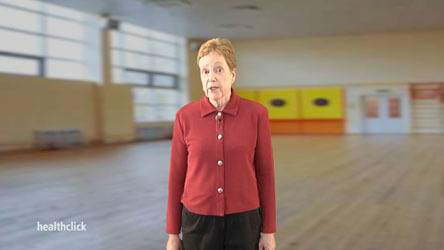
Carol McFarland, PT, PhD, OCS, is a 1975 graduate of Boston University with a BS in physical therapy. She completed her MS in kinesiology at University of Texas at Tyler in 1986 and then received her Orthopaedic Clinical Specialist certification from the American Board of Physical Therapy Specialties in 1990, which was renewed in 1998. She practices in an outpatient spine center in Texas and has worked closely with the neurosurgeons in this practice since 1992. She collaborated with therapists throughout east Texas to develop rehabilitation protocols specifically for follow-up to many of the surgical and injection spine procedures. She presented these protocols through the Texas Physical Therapy Association and American Back Society several times, and published a book on the postsurgical protocols for the lumbar spine.
Course Objectives
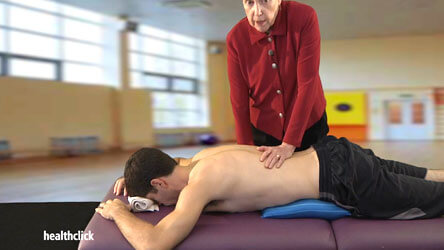
Upon completion of this course the participant will be able to:
- Understand the fundamental components of a post op spinal evaluation
- Identify the standardized outcomes tools that can be utilized to track and compare outcomes
- Perform a post operative spinal evaluation utilizing certain techniques for the varying stages of post- op progression.
- Identify specific tests to utilized during a neurological exam
- Define the four functional loss characteristics
- Teach a patient to activate specific muscles for segmental stabilization in the lumbar spine
- Perform appropriate manual therapy and exercises techniques for a variety of post op spine diagnoses
- Develop a progressive program for the cervical and lumbar spine to decrease pain, improve strength, stability and function outcomes.
Learn to perform a thorough post operative spinal evaluation
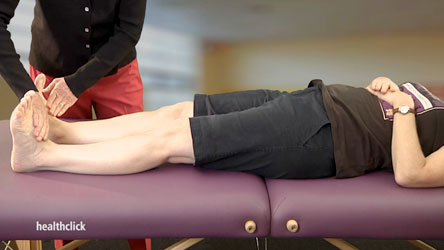
- Patient history questions: onset
- Patient history questions: pain and symptom descriptions
- Patient history questions: patient's physical characteristics
- Outcome instruments: Oswestry and Neck Disability Index
- Early postoperative spinal evaluation components and pointers: Symptom description, incision assessment, spinal contour, functional mobility description
- Early postoperative spinal evaluation components and pointers: Postural Assessments
- Early postoperative spinal evaluation components and pointers: Neurologic testing
- Early postoperative spinal evaluation components and pointers: Body mechanics during functional movements
Perform post surgical lumbar spine evaluation

- Neurologic exam demonstration: dermatome testing for lumbar spine using light touch
- Neurologic exam demonstration: myotome testing for early postoperative lumbar spine
- Assessing proper log roll and safe supine to sit transition. Ideas for patient instruction
- Initial straight leg raise test for neural tension. Instructions to patient if positive
- Discussion of muscles for segmental stabilization in the lumbar spine: tranversus abdominis and multifidus
- Increasing evidence of the importance of segmental stabilizers for protection of the spine during movement and loading
- Importance of training the segmental stabilizers specifically
- Additional stabilization with superior and inferior support for the lumbar spine from pelvic floor and diaphragm
- Evaluating transverse abdominis (lumbar segmental stabilizer) muscle performance using Stabilizer
Detailed Information on a post operative cervical spine evaluation
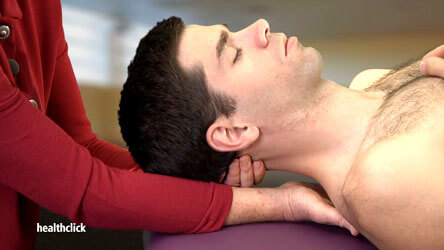
- Evaluating deep cervical flexors (segmental stabilizers) using Stabilizer
- Cervical spine neurologic exam: motor testing
- Cervical spine neurologic exam: sensory testing using light touch
- Cervical spine neurologic exam: Upper limb tension testing
Post Operative Manual Therapy of the Lumbar Spine
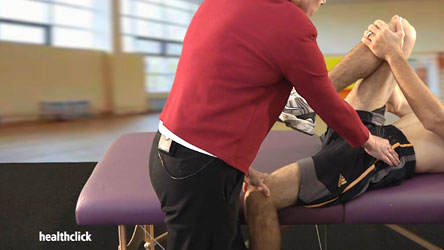
- Manual therapy lumbar spine: soft tissue mobilization along incision
- Manual therapy lumbar spine: soft tissue mobilization in sidelying for lumbodorsal fascia, quadratus lumborum, and hip muscle complex
- Manual therapy lumbar spine: contract/relax to quadratus lumborum in sidelying
- Manual therapy lumbar spine: contract/relax to iliopsoas in supine
- Manual therapy lumbar spine: contract/relax to iliopsoas in supine, taking leg off the treatment table
- Muscle facilitation of hip rotators with patient in prone position: using manual resistance and assessment of right to left differences
- Manual therapy lumbar spine: posterior /anterior pressures to lumbar spine to help patients increase mobility into extension
- Manual therapy lumbar spine: close up of posterior /anterior pressures on L spine
- Manual therapy lumbar spine: Passive intervertebral motion into flexion in sidelying, for spinal stenosis or artificial disc replacement
- Manual therapy lumbar spine: Passive intervertebral motion into lateral flexion in sidelying, with painful side up, for spinal stenosis or artificial disc replacement
- Manual therapy lumbar spine: muscle facilitation in sidelying directed towards hip rotators
- Manual therapy lumbar spine: rhythmic stabilization in supine for trunk muscle facilitation
- Manual therapy lumbar spine: seated localized muscle recruitment with manual resistance at each vertebral level
- Manual therapy lumbar spine: sidelying localized muscle recruitment with manual resistance at each vertebral level
Post Operative Manual Therapy of the Cervical Spine
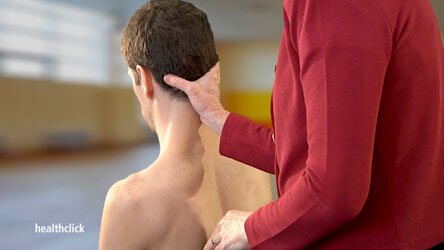
- Introduction to cervical spine manual therapy section: Description of techniques
- Assisted shrug with upper trap stretch, using contract/ relax/ stretch technique, maintaining neutral cervical spine
- Seated levator scapula stretch, using contract/ relax/ stretch technique, maintaining neutral cervical spine
- Seated scalene stretch, using contract/ relax/ stretch technique, maintaining neutral cervical spine
- Seated stretch of upper cervical and thoracic paraspinals using contract/ relax/ stretch technique, with cervical spine in slight flexion
- Seated suboccipital release with thumb pressure below occiput
- Alternative hand placement for suboccipital release for patients with pressure sensitivity in upper cervical musculature
- Levator scapula contract/ relax/ stretch release with patient in supine, maintaining neutral cervical spine
- Scalene contract/ relax/ stretch release with patient in supine, maintaining neutral cervical spine
- Clarification of hand placement on scapula for levator scapula release. Clarification of hand placement on upper thoracic paraspinals for cervical and upper thoracic paraspinal release
- Cervical and upper thoracic paraspinal release and elongation stretch with patient in supine, maintaining neutral cervical spine
- Supine suboccipital release, maintained pressure over tendon attachments with neutral cervical spine
Course Test - Evaluate your knowledge

- Use the Healthclick proprietary online education system which provides the online student with:
- Worldwide access to high definition video, anatomical animations and images, and written information
- The highest quality film in the industry, you can see the difference!
- Stop and resume within a course, the Healthclick system will optimize your course based on your device, connection and remembers where you left off.
- Real-time course updates. We are always adding to each courses, updating content, adding animations, these are not static courses!
- Evaluate your knowledge with the course test on any device.
- Print your state course certificate for CE credit.
- Take the online test as many times as need in order to achieve a 70 % or greater score.
Responsible CME® - Online CEU Course Testimonials
67.225.255.111Yes, this will be helpful in sharing the manual techniques with my staff. -- Sean, Physical Therapist
It is beneficial to have the video for manual techniques -- Chi, Physical Therapist
Good techniques for post surgical patients -- Michelle, PT
Easy to follow along, informative. -- Rosemary, PT
Great courses! Very useful! -- Sean, PhysicalTherapist
Great course, I would use this again -- Daniel, PT